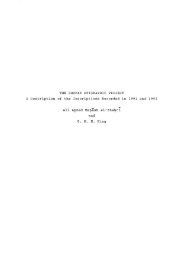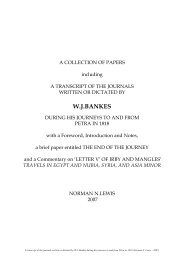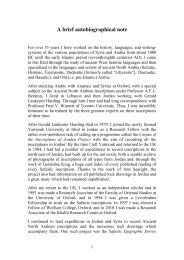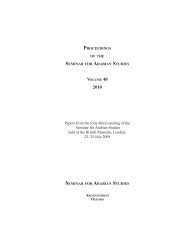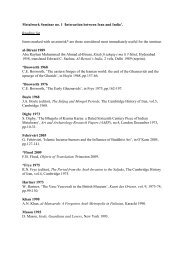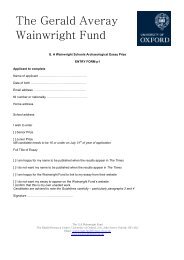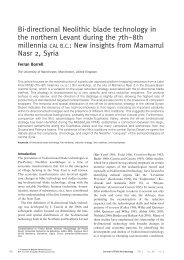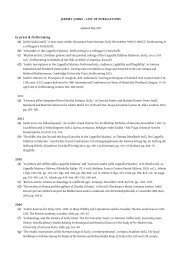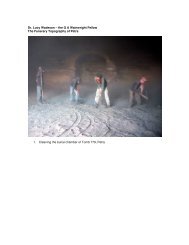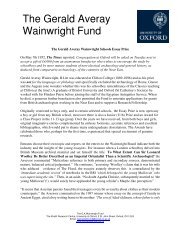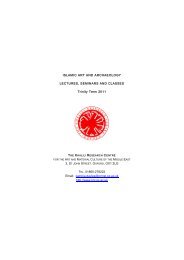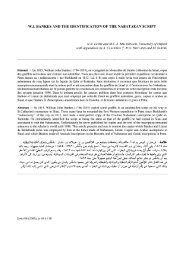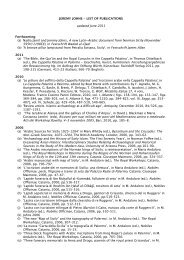Reflections on the linguistic map of pre-Islamic Arabia - Khalili ...
Reflections on the linguistic map of pre-Islamic Arabia - Khalili ...
Reflections on the linguistic map of pre-Islamic Arabia - Khalili ...
You also want an ePaper? Increase the reach of your titles
YUMPU automatically turns print PDFs into web optimized ePapers that Google loves.
I would <strong>the</strong>refore suggest <strong>the</strong> following<br />
alternative explanati<strong>on</strong>.<br />
1) The texts from Haram and those from<br />
Qaryat al-Faw should be c<strong>on</strong>sidered separately.<br />
The geographical positi<strong>on</strong>s, histories<br />
(as far as we can tell), social and cultural<br />
lives <strong>of</strong> <strong>the</strong> two towns appear to have been<br />
very different. Haram, even in <strong>the</strong> Amīrite<br />
period, was firmly within <strong>the</strong> Sabaean<br />
cultural sphere, even if <strong>the</strong> dominant part<br />
<strong>of</strong> <strong>the</strong> populati<strong>on</strong> may have hailed originally<br />
from nor<strong>the</strong>rn nomad stock (229).<br />
Faw, <strong>on</strong> <strong>the</strong> o<strong>the</strong>r hand, was an entirely<br />
Central <strong>Arabia</strong>n town, albeit an extremely<br />
cosmopolitan <strong>on</strong>e. Certainly, <strong>the</strong>re was<br />
str<strong>on</strong>g Sabaean influence <strong>the</strong>re – Saba $ was<br />
its most powerful neighbour – but it was<br />
<strong>on</strong>ly <strong>on</strong>e element am<strong>on</strong>g many, and I do<br />
not get <strong>the</strong> im<strong>pre</strong>ssi<strong>on</strong> that it was in any<br />
way ‘a South <strong>Arabia</strong>n town’.<br />
2) At Haram, <strong>the</strong> limited range and nature<br />
<strong>of</strong> <strong>the</strong> n<strong>on</strong>-Sabaic elements in <strong>the</strong> Sabaeo-North-<strong>Arabia</strong>n<br />
inscripti<strong>on</strong>s suggest<br />
that <strong>the</strong>y are clumsy attempts at writing<br />
correct Sabaic by people whose mo<strong>the</strong>r<br />
t<strong>on</strong>gue was ei<strong>the</strong>r a different language, or a<br />
dialect <strong>of</strong> Sabaic which c<strong>on</strong>tained elements<br />
from ano<strong>the</strong>r language.<br />
3) At Qaryat al-Faw, <strong>on</strong> <strong>the</strong> o<strong>the</strong>r hand,<br />
<strong>the</strong> situati<strong>on</strong> is more complex. Here it<br />
seems very probable that at least two forms<br />
<strong>of</strong> North <strong>Arabia</strong>n coexisted: Old Arabic<br />
and <strong>on</strong>e or more, as yet undefined, dialects<br />
<strong>of</strong> ANA. There are a handful <strong>of</strong> texts in Old<br />
Arabic and ANA written in <strong>the</strong> Sabaic<br />
script, but we cannot know how wides<strong>pre</strong>ad<br />
this practice was until <strong>the</strong> Faw<br />
inscripti<strong>on</strong>s are fully published. However,<br />
<strong>the</strong>re are also texts at Faw couched in <strong>the</strong><br />
Sabaic language with <strong>on</strong>ly a few North<br />
<strong>Arabia</strong>n intrusi<strong>on</strong>s and I would suggest<br />
that <strong>the</strong>se, like <strong>the</strong> Sabaeo-North-<strong>Arabia</strong>n<br />
inscripti<strong>on</strong>s at Haram, are <strong>the</strong> products <strong>of</strong><br />
North-<strong>Arabia</strong>n speakers trying, not entirely<br />
successfully, to write correct Sabaic.<br />
4) Too few inscripti<strong>on</strong>s from Nagˇrān<br />
THE LINGUISTIC MAP OF PRE-ISLAMIC ARABIA<br />
have been published to make any realistic<br />
judgement <strong>on</strong> <strong>the</strong> <strong>linguistic</strong> situati<strong>on</strong> <strong>the</strong>re,<br />
although given its geographical positi<strong>on</strong><br />
<strong>on</strong>e would obviously expect <strong>the</strong>re to have<br />
been a mixture <strong>of</strong> North <strong>Arabia</strong>n and Ancient<br />
South <strong>Arabia</strong>n languages. We can<br />
<strong>on</strong>ly hope that more texts will appear in<br />
<strong>the</strong> near future.<br />
The late Pre-<strong>Islamic</strong> period<br />
As we have seen, <strong>the</strong>re are remarkably few<br />
documents in Old Arabic, and until <strong>the</strong><br />
sixth century AD <strong>the</strong>re was no single script<br />
associated with it. This implies that, until<br />
<strong>the</strong> period immediately before <strong>the</strong> rise <strong>of</strong><br />
Islam, it remained a vernacular in societies<br />
which were ei<strong>the</strong>r n<strong>on</strong>-literate or which<br />
wrote in o<strong>the</strong>r languages – Sabaic, Ancient<br />
North <strong>Arabia</strong>n, Aramaic, Greek. We can<br />
<strong>on</strong>ly guess at <strong>the</strong> reas<strong>on</strong>s for this and <strong>the</strong><br />
reas<strong>on</strong>s why, <strong>on</strong> occasi<strong>on</strong>s, Old Arabic was<br />
written. In <strong>the</strong> late first millennium BC and<br />
<strong>the</strong> early first millennium AD, it was <strong>pre</strong>sumably<br />
<strong>the</strong> vernacular <strong>of</strong> groups which<br />
were basically n<strong>on</strong>-literate, perhaps primarily<br />
nomadic, which when <strong>the</strong>y moved into<br />
situati<strong>on</strong>s where literacy was necessary –<br />
eg. c<strong>on</strong>tact with settled peoples – found<br />
writing systems associated with o<strong>the</strong>r languages<br />
already established. Those who<br />
wanted to write would <strong>the</strong>refore have had<br />
to learn <strong>the</strong> rudiments <strong>of</strong> <strong>the</strong> language associated<br />
with <strong>the</strong> script, or simply have<br />
had <strong>the</strong>ir texts written for <strong>the</strong>m by scribes<br />
and mas<strong>on</strong>s. Only in very special circumstances<br />
would an individual have insisted<br />
<strong>on</strong> his text being ex<strong>pre</strong>ssed in <strong>the</strong><br />
vernacular, and <strong>the</strong> problems that this<br />
caused <strong>the</strong> scribes and mas<strong>on</strong>s in adapting<br />
<strong>the</strong> orthographic c<strong>on</strong>venti<strong>on</strong>s <strong>of</strong> <strong>on</strong>e language<br />
to an unfamiliar t<strong>on</strong>gue, can be seen<br />
both in <strong>the</strong> true and mixed Old Arabic texts<br />
and in <strong>the</strong> Undifferentiated-North-<strong>Arabia</strong>n<br />
inscripti<strong>on</strong>s. Since several <strong>of</strong> <strong>the</strong>se texts in<br />
ANA and Old Arabic (or approximati<strong>on</strong>s<br />
57



